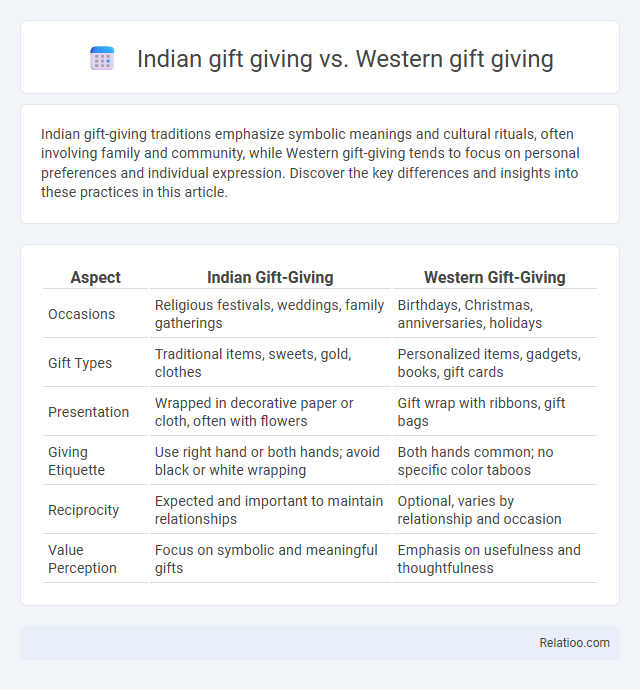Indian gift-giving traditions emphasize symbolic meanings and cultural rituals, often involving family and community, while Western gift-giving tends to focus on personal preferences and individual expression. Discover the key differences and insights into these practices in this article.
Table of Comparison
| Aspect | Indian Gift-Giving | Western Gift-Giving |
|---|---|---|
| Occasions | Religious festivals, weddings, family gatherings | Birthdays, Christmas, anniversaries, holidays |
| Gift Types | Traditional items, sweets, gold, clothes | Personalized items, gadgets, books, gift cards |
| Presentation | Wrapped in decorative paper or cloth, often with flowers | Gift wrap with ribbons, gift bags |
| Giving Etiquette | Use right hand or both hands; avoid black or white wrapping | Both hands common; no specific color taboos |
| Reciprocity | Expected and important to maintain relationships | Optional, varies by relationship and occasion |
| Value Perception | Focus on symbolic and meaningful gifts | Emphasis on usefulness and thoughtfulness |
Cultural Foundations of Gift-Giving: India vs. the West
Indian gift-giving is deeply rooted in cultural traditions emphasizing reciprocity, social hierarchy, and auspicious timing, often influenced by religious festivals and family bonds. Western gift-giving prioritizes individual expression, personal choice, and occasions like birthdays and holidays, reflecting a more secular and egalitarian approach. These cultural foundations shape the symbolic meanings and social functions of gifts within their respective societies, highlighting contrasts in values and interpersonal dynamics.
Traditional Occasions for Gifting in Both Cultures
Traditional gift-giving in Indian culture revolves around festivals like Diwali and weddings, where gifts such as sweets, gold, and clothes symbolize prosperity and respect. In Western cultures, occasions like Christmas and birthdays are prominent for giving gifts that reflect personal appreciation and celebration. Your understanding of these cultural nuances enhances meaningful exchanges during these significant traditional occasions.
Social Etiquette and Gift Selection
In Indian gift-giving, social etiquette emphasizes respect and timing, often involving the presentation of gifts with the right hand or both hands as a sign of reverence, and gifts are typically wrapped in bright colors symbolizing auspiciousness. Western gift-giving prioritizes personalization and practicality, with a focus on occasions such as birthdays and holidays, where the choice of gift reflects the recipient's interests while adhering to social norms like avoiding overly expensive items. Your understanding of these cultural nuances can enhance your gift selection, ensuring that the gesture is both appropriate and appreciated across different social settings.
Meaning and Symbolism Behind Gifts
Indian gift-giving emphasizes deep symbolism, often linked to religious beliefs and cultural traditions, where gifts like sweets, clothing, or gold signify blessings, prosperity, and respect. Western gift-giving typically centers on personal expression and celebrating milestones, with thoughtful or practical gifts reflecting appreciation and individual connection. Understanding these cultural nuances enriches your gift-giving experience, ensuring that the meaning behind your chosen present resonates with its recipient.
The Role of Religion in Gift-Giving Practices
In Indian gift-giving, religion profoundly shapes customs, with Hinduism emphasizing auspicious offerings during festivals and rituals, while Islam influences gift exchanges during Eid, reflecting spiritual gratitude and community bonding. Western gift-giving often centers around Christian holidays such as Christmas and Easter, where gifts symbolize generosity and the spirit of giving rooted in religious narratives. Across cultures, religion provides a moral framework that dictates appropriate gifts, timing, and the symbolic meanings attached to gift-giving traditions.
Gift Presentation: Wrapping and Delivery Differences
Gift presentation in Indian cultures emphasizes vibrant, ornate wrapping using rich fabrics, bright colors, and elaborate decorations reflecting auspiciousness, while Western gift-giving often favors sleek paper wrapping with ribbons or minimalistic designs for elegance. Delivery methods in India frequently involve personal handovers during ceremonies or festivals, highlighting respect and tradition, whereas Western practices commonly include postal or courier services for convenience and surprise. You can enhance your gift's impact by understanding these cultural nuances in wrapping and delivery.
Importance of Reciprocity and Obligation
In Indian gift-giving, reciprocity and obligation are deeply rooted in cultural traditions, emphasizing maintaining social harmony and long-term relationships through balanced exchanges. Western gift-giving often centers on personal expression and voluntary generosity, with less rigid expectations of reciprocation but still appreciating mutual goodwill. Overall, the importance of reciprocity and obligation varies widely, with Indian customs placing greater social pressure on reciprocal gifting compared to the more individualistic and spontaneous nature of Western practices.
Gifts to Avoid: Taboos and Cultural Faux Pas
In Indian gift-giving, it is considered taboo to present clocks, handkerchiefs, or leather items, as they symbolize bad luck or are associated with mortality, while Western cultures often avoid gifting sharp objects like knives that imply severing relationships. Gift-giving across cultures demands sensitivity to symbolic meanings; for instance, giving white flowers in India is linked to funerals, whereas in Western contexts, red roses typically convey romantic intentions. Respecting these cultural nuances prevents misunderstandings and ensures that gifts are received with appreciation rather than offense.
Modern Influences and Globalization Effects
Indian gift-giving emphasizes symbolic meanings and deeply rooted cultural traditions, often involving elaborate rituals and family-centric exchanges, while Western gift-giving prioritizes practicality and personal preferences shaped by individualism. Modern influences such as digital shopping platforms and social media have accelerated cross-cultural exchanges, leading to hybrid practices that blend Indian formality with Western convenience and style. Globalization fosters more diverse gift choices and occasions, breaking traditional norms and encouraging personalized, experience-based gifting across both cultures.
Navigating Cross-Cultural Gift-Giving Situations
Navigating cross-cultural gift-giving situations requires understanding Indian gift-giving customs, which emphasize thoughtful presentation, often with symbolic wrapping and the avoidance of certain gifts like clocks or handkerchiefs due to superstition. Western gift-giving typically prioritizes practicality and individual preference, with a casual approach to wrapping and a focus on the recipient's hobbies or needs. When you engage in gift-giving across cultures, respecting these distinct traditions helps foster goodwill and prevents misunderstandings.

Infographic: Indian gift-giving vs Western gift-giving
 relatioo.com
relatioo.com